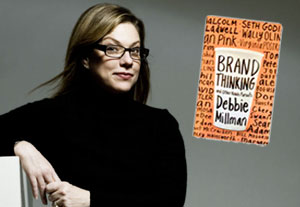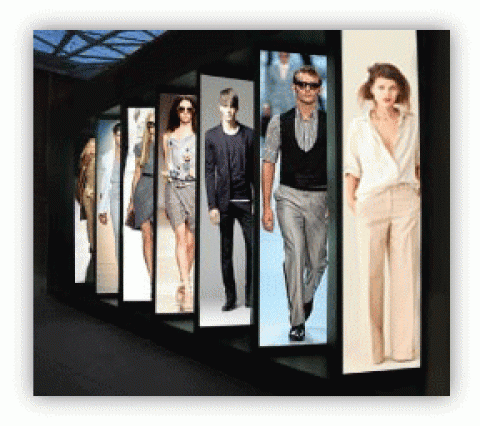 By Debbie Millman
By Debbie Millman
In his foreword, Rob Walker describes Debbie’s Millman’s latest book, “Brand Thinking and Other Noble Pursuits” this way, “It’s like a buzzing dinner party, where you never know who is going to say what.”
PaperSpecs is excited to be able to present this fascinating and provocative excerpt – Ms. Millman’s conversation with Karim Rashid, founder, designer, Karim Rashid Inc.
In her intro to this chapter, Millman writes, “Talking with Karim Rashid is a little disorienting. Intoxicating. Heady. He is not the design couturier that some take him to be. As he makes evident in this conversation, he is very much an advocate for the democratization of design, which he feels is the only valid way of working now – creating good design that lasts, is accessible, and is affordable. He acknowledges his own transformation over the years, saying, ‘Look, I’ve made couches that are very expensive, and they embarrass me now.’”
KR: Debbie, before we start, I want to say that what you are doing is totally necessary.
DM: Necessary?
KR: Yes. Yours are the peripheral professions around designing things, and the design world needs that support.
DM: What do you mean by “peripheral”?
I mean the critics, the people publishing books, the people running design shops, design galleries, design blogs, and so on. This is all completely necessary. I just returned to give a lecture at the college I graduated from nearly thirty years ago. It was so bizarre! I stood in the same lecture hall where I remember seeing Ettore Sottsass, Achille Castiglioni, and Marshall McLuhan speak.
And there I was, speaking to the audience, twenty-eight years later. Twenty-eight years ago, the design profession was completely unheard-of. It was a marginal discipline. Nobody talked about it. The few people who wrote about it were in academia, and it was removed from everyday life. And now, three decades later, everybody is talking about design.
DM: What changed?
Three things. The obvious one has to do with the digital age. Communication is now omnipresent and information is omnipresent. The second fact is that the design of our products has gotten better. There was a time when engineers designed most products. The rest were reverse-engineered, where people would just pull apart other people’s products and copy them. The third is that products have become more inexpensive and more accessible. In the past, you couldn’t walk into a CB2 and buy a nice, well-made, contemporary chair for $150. You couldn’t go to Alessi and buy a well-designed little watch for $75.
These things were just not accessible years ago. Back in the ’70s, we had Habitat—that’s where we went. My father loved that store. My father was a set designer for television, and he was a painter.
He liked design. But he was in a middle- to low-income bracket, so he wasn’t in a position to buy expensive things. There were only a few companies making affordable things at that time. There were a few in the kitchen world, but in general, you couldn’t really fill your house with nicely designed things even if you were middle-class. Even back then, in 1960, the famous Charles Eames chair sold for $90 retail, which is the equivalent now to $800.
We talk about Eames making “democratic” products, but they weren’t really. The production processes and technologies weren’t sophisticated enough to make things that were truly inexpensive.
So, that’s the difference. That chair could actually retail now for about $29. I’m not talking about the Herman Miller version—I’m saying you could make a similar chair for about $30–$40 retail.
DM: Well, you’ve done that. You’ve created chairs like that for mass production.
I have an obsession with what I call “designocracy.” This is because I loved staring at the bright orange Braun alarm-clock radio on my desk when I was eleven years old. I have a shelf full of objects that I’ve had since I was a kid. You could argue they were more interesting and more conceptual than most of the high-tech products made now. When I first went into design school, I felt I’d be contributing to the world of cool things that everybody would have.
DM: What made you decide to go to design school?
I think the catalyst was probably a Raymond Loewy book my father bought me when I was fourteen years old.
DM: Why did he buy it for you?
He saw that I spent a lot of time drawing objects. I wasn’t really drawing families and . . .
Trees and suns and flowers and . . .
Landscapes. I was drawing things in the house and then redesigning them.
DM: A few moments ago, you mentioned the term “designocracy.” What do you mean by that?
It’s my term for the democratization of design. Honestly, this is the only real way to work in the design world. If you really want to make an impact, if you really want to make people’s lives better, if you really want to make change, and if you are concerned about this planet on every level—you have to make democratic things. Because, frankly, if you open up a magazine, or go to a museum, or buy a book, you can see some chair that everybody knows represents a certain image. But no one ever gets to sit on it. This doesn’t make sense to me anymore. It’s bullshit. Look, I’ve made couches that are very expensive, and they embarrass me now. But the reality is that I’ve learned. I know how to make people love design. The way to accomplish this is by designing democratic things. Our iconic designers are making things that are inaccessible. This is wrong. Design is not art.
DM: Why not?
An artist is somebody in a particular field who wants to make change, and doesn’t use a textbook to figure out what that’s going to be. They actually write a new textbook, and they move the profession forward. They evolve the profession. The artist is someone who seeks to do something original.
That’s it. For many years, industrial design was a service industry. A company came along and told you how to make things. I came to this profession not wanting to do that.
It’s true that the artist in me always tries to do something original. But design is not art. The minute you use the word “design,” it signifies that whatever you make has to be used by people. When we say that it has to be used by people, that means you’re using technology to mass-produce something. You are not making a one-off—that’s not design. For me, design has become a democratic art, because it allows everybody to have nice, beautiful things that make their lives more pleasurable, or more enjoyable, or more artistic, or more emotional, or more expressive, or whatever. But this “democratic art” is not art. In fact, art—to me—is an embarrassing world to be in.
DM: How is it embarrassing?
Because it’s ostentatious—it’s removed. The art world is intentionally doing everything in its power to become more and more elite in order to keep the art business alive. But the reality is this: Art is becoming less and less relevant.
DM: Why? Is it because the art isn’t as good?
No. It’s because technology has empowered more people to be creative. There’s an old saying that goes something like this: “An artist cannot compete with a man on the moon in your living room.”
Our real artists are making films in Hollywood. They’re making Avatar. They’re out there shaping the world for everybody. This is where all the real artists are. The artists hanging out in the art world are social misfits who like playing with paper.
DM: On your website, your manifesto states that design has been a cultural shaper of our world from the start of civilization.
I was just in Shanghai, and I went to a museum and looked at beautiful urns from the Ming dynasty. I realized that this is how we understand and dissect our past. We learn through artifacts. We learn about the civilities of the time, the religions of the time, and the socio-behavioral constructs of the time. The objects denote our existence.
DM: How do they denote our existence?
They describe the conduct of the time, the religion of the time, the behavior of the time.
DM: So this is evidence?
Yes. It’s physical evidence of our existence. But now that we’re in a digital age, I think things are shifting and changing. Yet, historically, these artifacts were the only way we understood who we were, or where we came from, or what we did. I think about this every time I design anything.
I imagine burying everything I designed today. If someone excavated it in the year 3500, what would it say about the time in which we live now? I think the first thing they would understand relates to how we made things.
In the last 10,000 years, prior to the Industrial Revolution, we made things by hand, and our tools were very primitive. The future generations would be able to see the evolution of our process of making things with EBM [extrusion blow molding] machines and rapid prototype machines as well as with injection molding and blow molding. They would be able to draw a timeline of our industrial production processes.
DM: What do you think they would be able to determine about our culture and our society right now?
They’d see that we are living in what I call “the casual age.” My theory is that this actually began in tandem with the concept of casual Fridays. Once that became the norm, Fridays then extended into Thursdays and Wednesdays, and so forth. The next thing you know, people are walking around New York at two in the afternoon, and they look like they just rolled out of bed. Or they’re wearing flip-flops in November. I just read that 70 percent of the world’s shoe market now consists of running shoes—which is phenomenal. When you go to the airport and you see the shoeshine man with no work, you know why.
The men’s tie business has been cut in half during the last decade. Men are not wearing ties anymore. The same dynamic exists in the panty hose business. When was the last time you saw a woman in panty hose?
DM: What do you think this says about us as people?
I think that we now have the freedom to be individuals. And we have the ability to avoid hiding behind uniforms.
DM: But isn’t there just a different uniform now?
Not really. If everyone on Wall Street wears a suit and tie, and I go to Wall Street and wear pink, I’m signaling my individuality. Then I’m not lumped into this huge, conforming group. If I wanted to hire a lawyer, I would much rather hire a lawyer who has his own way of dressing and doesn’t wear what a lawyer would typically have to wear.
DM Yes, but that’s you, Karim. There’s still a uniform for casual Fridays. Think about all those awful beige khakis and horrible polo shirts.
You’re right. Look—I’m an idealist. I think the uniform is a form of suppression. But, if I had to guess, I would say that disbanding the uniform for a more individualistic expression allows for a healthier way for humans to evolve. Even the term “act your age” has disappeared. I’m not a typical fifty-year-old, but I know a lot of fifty-year-olds who are listening to dance music and driving around in SUVs. They’re wearing ripped jeans, the latest Nikes, and all the rest of it. They’re not acting the way that fifty-year-olds are supposed to act.
DM: You’ve said that every business should be concerned with beauty because it’s a collective human need. What does beauty mean to you?
Historically, humans have always been obsessed with beauty on every level. Not only for ourselves, but as it relates to our surroundings, our architecture, our faces. You could argue that we’re even more obsessed today. You could look at the plastic surgery that’s done nowadays and say that we’re becoming so self-absorbed. But even the ancient Egyptians were doing operations to change the shape of people’s noses, and there were other forms of implants over the centuries.
Today, beauty is not as much about fitting into a certain sect, tribe, or trend—it’s much more about you expressing your own beauty. But to do that, you need to figure out who you are.
Let’s put it this way: If we were brought up or educated in a way that supported this notion of being an individual, and that the greatest thing we each possessed was our unique fingerprint and DNA, the world would be a completely different place.
But what do we do? We do the opposite. Think about it. At first, kids are all creative. At three or four years old, they’re so perceptive and in-the-moment. And they’re so creative! Who gave us this desire, this need to create? It’s important to acknowledge that we all draw when we’re kids, by the way. We all do! We all finger-painted. When we’re young, we all make things. We all grab things. We all start by using our imagination.
And then all of a sudden, conformity comes along, and this conformity continues year after year after year, and all of a sudden, you’re just 27 years old, and for some reason you’ve become myopic about how you should live, how you should dress, how you should behave, and what you should do with your life. And self-expression is not given much priority among those considerations. It has become completely suppressed.
I think beauty is this sense of self-expression. The beauty is that we’re all actually different and creative. The beauty is that we are all completely diverse in every way—in our cognition, our mannerisms, everything. This isn’t a superficial kind of beauty.
DM: If humans have this inherent creativity and individuality, why do we have things like the shopping mall? Why do they exist?
At the end of the day, survival will override beauty. The shopping mall is part of our contemporary, pathological need to consume. We live in a world where consuming is a big part of our existence. But let me play devil’s advocate for a moment. In the past, there was a time when I had to run around all over a city to find certain things that I wanted. Now I don’t have to do that. When I go to the shopping mall, I can get everything in one place. I’m protected from the elements of nature. The climate is right. The air-conditioning is right. That’s beautiful, isn’t it?
DM: Does it bother you that you can go to almost any shopping mall in the United States and find the same stores selling the exact same things?
That’s capitalism. The mall is simply convenient. And frankly, they’re not even doing that well anymore. Why? Because of online shopping! I loved shopping in stores, but for the last 10 years, I’ve bought almost everything online. I barely go into stores anymore. Why should I? When I shop online, I have the world at my fingertips. I can shop in the “world mall.” I have more choice than ever, and I’m more informed about everything that I’m buying.
DM: What do you love about shopping?
To see what people are making, and to see what the world is offering. I have no issues with consumption. I have issues with consuming things that we don’t need and that are badly made. I have issues with things that break down or cause harm. But there’s nothing wrong with consuming. A lot of what we consume gives us a better life. Our quality of life is better today than it’s ever been in our history. That’s a fact. Even if one-quarter of the world doesn’t have fresh drinking water, the reality is that the majority of the world is living a better life. Why is that? It’s because the things that we have in our lives make our lives better. You could argue that the original intention of design is the betterment of society.
DM: I assume that this is why your motto is “I want to change the world”?
Well, I have several mottos, but yes, I want to change the world. I first said that 12 years ago, and it was primarily because people did not believe that design could change the world. But anything— anything—a person puts out in the world has the power to change it. The world we’ve created and built consists entirely of design. And every other day, there’s an improvement on something.
DM: Do you think these views are now part of the “Karim Rashid” brand?
Perhaps. So many people keep talking to me about how I have a brand and how I have this and how I have that. I don’t really have a brand—I have an identity.
DM: You used to wear white all the time—now you wear pink a lot.
I wear both. If you walk into my wardrobe, the left side is white and the right side is pink.
DM: Why?
Because that’s me. I decided that’s me. I knew it years ago. I found a picture of myself when I was five years old, and I was dressed all in pink.
DM: What is it about those two particular colors that you find so compelling?
With white, I feel a sense of liberation—of freedom and autonomy. It’s almost like a white canvas: you have no baggage.
DM: What about pink?
To me, pink is the most passionate color there is.
DM: Because . . .
It just speaks about passion. If you have a pink aura, you’re known as a passionate person.
DM: When I interviewed Massimo Vignelli, he told me that black, white and red were the only colors designers should use—all of the other colors were only good for flowers.
Oh, really?
DM: Yes.
He’s a fascist—tell him I said that. Every color in the world should exist. And it does exist. In nature, everything from phosphorescent lime to beautiful electric blue—everything exists. I love color. I use a hell of a lot of color in all my work. The human eye can see 16,000 colors. Why limit yourself when there are so many possibilities?
DM: Getting back to what we were talking about—how would you define the term “brand”?
A brand is basically a business that has an identity. If it doesn’t have an identity, it’s not a brand. You should be able to say to somebody, “Shut your eyes and tell me what you see when you hear the words
‘Calvin Klein.’” If I shut my eyes and think of Calvin Klein, I see gray, black, and little else. But that’s his brand. It’s very minimalist, and it’s vague. This is always my test for companies. I had a meeting the other day with people from Unilever, and I said to them, “When people close their eyes and think about your brands, what do they see?” And it was really funny, the people at the table did this, and every one of them saw the exact same thing.
DM: Was it something embarrassing?
Somewhat. Last year, I was at the Russia Forum in Moscow to give a lecture on entrepreneurship. There were 4,000 people there. I had the audacity to tell the Russians that they don’t have any brands. Yet consider a country like Sweden, which has only 6,000,000 people. I can name 10 Swedish brands right now that we all know. And I basically asked the Russians, “Why is that?” The Russians have the know-how; they have the intellect. They’re well educated people, and they have the technology. How come they don’t have any brands?
DM: What did they say?
The minister of economic development got very upset and told me I shouldn’t be speaking that way. But I told him this could change quickly. You can design three or four fantastic things for an unknown company, and within a year, the brand is known around the world.
DM: Isn’t that what you did for Method when you designed some of their products?
Yes. Fantastic example. And Method had no money. This is the new world we live in now. People are realizing the power of design on every level. Look, people invest money to make things, so why can’t they be beautiful? Why can’t they work? If something has to physically exist in the world, why can’t it be uncategorically better than whatever else is on the market?
We should tell young designers not to worry about what they’re going to do with their design careers. They should start their own brands. Designers should create their own beautiful brands that can change the world.
———-
Copyright 2011 Debbie Millman. This excerpt is published here with permission of Allworth Press.
To purchase Millman’s book, Brand Thinking and Other Noble Pursuits, please go to the PaperSpecs Book Corner.











